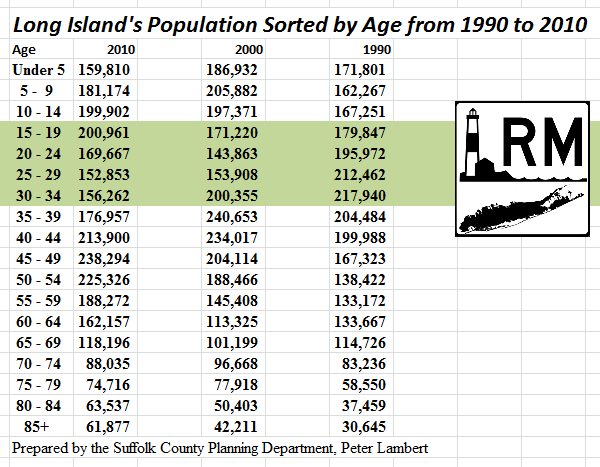Last week, my piece on affordable housing options for Long Island’s millennials went viral, being shared across Twitter, LinkedIn and in urban planning circles. Thank you for supporting my message of informed policymaking. I explored the region’s tendency to accept developer-driven solutions for our housing woes, and the lack of sound planning that is often presented as an answer to how we can keep the region’s young professionals. Similar to the discussion of affordable housing, it’s time for Long Islanders to rethink the golden goose of “smart growth” advocates and developers: The Brain Drain.
Earlier this week, the Long Island Association’s Kevin Law wrote a rather concise op-ed in Newsday that in a nutshell, stated our median age is rising, and we must employ smart growth principles to help retain our young. According to Law, if we don’t build more rentals, we will continue to see the median age of the region climb. In 1980, 9% of Suffolk’s population was aged 65 or older, and in 2010 that number has climbed to 13.5%. The op-ed was sound, well written and informative, but it made an observation in passing that is in fact, the crux of our regional issues. In the piece, Law writes:
Also, the number of newborns to 4-year-olds in Nassau and Suffolk dropped from 186,932 in 2000 to 158,008 in 2011 — a 15 percent decline. The so-called birth dearth has been going on for 30 years. People are marrying later and having fewer children. It is no wonder 70 percent of districts have shown declines in elementary school enrollment in the past six years.
Look at the Numbers
Our demographics are changing, and always have been. Time and time again, I’ve quoted Dr. Seth Forman’s work on the myth of the brain drain, and I will continue to. Why are our young people leaving? As Dr. Koppelman has always said: “How can Long Island’s Young People leave if they were never born in the first place?”
It is perceived that the brain drain is the result of faulty housing policies, a lack of cool downtowns with microunits and a general unattractiveness of Nassau and Suffolk. Planners and demographers argue that in fact, the “primary driver of age cohorts” as Forman puts it, are changing patterns of birth and death rates. Let’s look at the numbers crunched by Forman in 2011, and start to re-prioritize the weight the “brain-drain” has on our regional policy and development recommendations.
For example, in 1980, there were 141,917 fewer children below the age of 10 than in 1970 in Nassau-Suffolk (484,145 vs. 342,228). This correlates roughly with the decline of 150,262 in the number of 10-19 year-olds between 1980 and 1990, the decline of 110,663 in the number of people between 20 and 29 years of age in the 1990s, and the decline of 107,657 in the number of people between the ages of 30 and 39 in the 2000s (441,008 vs. 333,351). (Source: Brain Drain or Birth Dearth, Seth Forman, 10/6/11)
Forman continues his argument:
Indeed, even as critics decry the “brain drain,” it looks like this pattern has started to partially reverse in Nassau-Suffolk. Because birth rates rose in the late 1980s and early 1990s, there has been a substantial increase in the number of people between 15 and 24 years of age in the past decade. The population aged 15-19 increased by 17.4 percent, between 2000 and 2010, while the 20-24 year-old group increased by 18 percent, for a total increase of 15-24 year-olds of 54,726 over the last ten years. If the correlation between housing costs and people in their early 20s was strong, it is unlikely that during a period when the median price of a single-family home increased by 66 percent (from $220,000 in 2000 to $366,000 in 2010), that the population in their early twenties would increase as well. (Source: Brain Drain or Birth Dearth, Seth Forman, 10/6/11)
Look at the numbers. From the 1990 to 2010, the number of 15-19 year olds on Long Island has increased by 21,114. The size of Long Island’s 20- 24 year old population has also grown by 25,804.
These future “Young Islanders” will eventually be in the 25-29 and 30-34 age groups, reflecting the birth/death rate at the time. To say that we’re hemorrhaging our young professionals is an exaggeration, and represents a cursory look at the demographics of Nassau and Suffolk Counties. Like everything else in the policy world, the “Brain Drain” we’re currently experiencing is cyclical. This is not to say that we shouldn’t invest in our downtowns, build closer to transit, and start to reverse the ills of suburbia, but young families will come back to Long Island when they are ready. Our schools, beaches and other unique assets are too special to deny.
I think it’s time we start to wholly understand our region’s changing demographics, and stop basing our large scale policy recommendations on a foundation of faulty generalizations, stakeholder bias and a flawed understanding of Long Island’s woes. It’s time to end the generalizations and start to give these complex problems the complex solutions they deserve.












